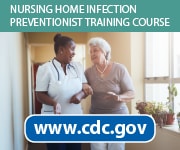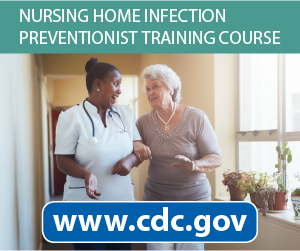How should nursing homes conduct COVID-19 testing?
It is estimated that between one-third and one-half of all COVID-19 deaths in the United States have occurred in nursing homes. Organizations providing care and housing for the elderly should perform regular testing of all residents and staff. The CDC has issued guidelines for COVID-19 testing in nursing homes and just updated and expanded those guidelines on June 25, 2020. All the appropriate links can be found at the bottom of this article. We encourage you to read them for yourself, but we have done our best to break down CDC and CMS’s wealth of information and guidelines into a form that is easier to understand.
This article is not intended to serve as the sole source of information from which to base decisions regarding care and testing. Consult other sources of information, including physicians, lawyers, and other professionals who are familiar with your facility and can offer more specific, customized advice for your community. This article will focus primarily on testing, not infection prevention and control methods as recommended by the CDC.
Step 1.
Appoint a person, or group of people, to be in charge of managing the crisis.
The person(s) appointed for managing the COVID-19 crisis will be responsible for developing infection prevention and control policies and procedures, performing infection surveillance, providing training of staff, and ensuring adherence to policies. This should be a full-time position for at least one person in facilities with more than 100 residents or that provide ventilator or dialysis services. Smaller facilities should still consider appointing a full-time position if resources allow.
The appointed person(s) should complete the CDC’s online Nursing Home Infection Preventionist Training Course.
When training has been completed, the CDC recommends you add one of their training course badges to your website to help reassure families and prospective clients that you are taking action to make your community safe and healthy during the crisis. Code snippets for the banners can be found on the CDC’s website here.
Step 2.
Comply with CMS reporting requirements by submitting weekly reports.
On May 8, 2020, the Center for Medicare and Medicaid Services (CMS) mandated certain COVID-19 reporting requirements including:
Suspected and confirmed COVID-19 infections among residents and staff, including residents previously treated for COVID-19
Total deaths and COVID-19 deaths among residents and staff
Personal protective equipment and hand hygiene supplies in the facility
Ventilator capacity and supplies in the facility
Resident beds and census
Access to COVID-19 testing while the resident is in the facility
Staffing shortages
Other information specified by the Secretary
Facilities must submit the data through the National Healthcare Safety Network (NHSN) COVID-19 Module at least once every seven days. All instructions for sign up, use, and reporting is included in the link above. We recommended the person(s) appointed to be responsible for managing the facility’s COVID-19 crisis be put in charge of completing this weekly reporting.
Step 3.
Create and follow through with a swab testing plan.
The CDC recommends that all residents and staff be tested on a regular basis. Testing intervals depend on how recently the last COVID-19 infection was identified. Swab (viral) testing should be the main testing method used because it identifies individuals with active infections during the first week of symptoms. Because antibodies can take as long as 2-3 weeks to develop after symptoms appear, they should not be used to diagnose COVID-19, but they can be used to supplement diagnosis, especially in cases where COVID-19 is suspected but the swab test gave a negative result. Below are our general recommendations for a testing plan. Specifics should be decided by physicians and other experts familiar with your facility’s residents, staff, and operations.
1. Establish COVID-19 Positive, Negative, and Suspected or Exposed Cohorts.
Positive.
The CDC recommends establishing a separate floor, wing, or cluster of rooms for COVID-19 positive residents and that staff be dedicated to only work with residents in this cohort and not be allowed to cross-provide care for residents in other cohorts. Residents in the Positive cohort can be moved back to the Negative cohort after 14 days of no symptoms or positive tests.
Suspected or Exposed.
If residents are suspected of COVID-19, such as when they are exhibiting symptoms, but are still awaiting test results, they should either be moved to a dedicated cohort, or should remain quarantined until test results are returned or illness disappears. After possible exposure to another resident with a confirmed case, exposed residents should be tested every 3-5 days even if asymptomatic. Residents can be moved back to the Negative cohort, or un-quarantined, after 14 days of no symptoms or positive tests. Immediately move positive residents to the Positive cohort.
Negative.
The same careful monitoring should be done for the Negative cohort. If a resident exhibits symptoms, tests positive during one of the regularly scheduled site-wide tests, or was exposed to a confirmed Positive case, they should be immediately moved to the appropriate cohort.
2. Perform an initial survey by testing all residents and staff.
Partner up with a lab that is qualified to perform COVID-19 viral testing. They must be CLIA-certified for high complexity testing and must have certain PCR instruments to run the tests. If you need help finding a qualified, equipped lab and ensuring they have enough testing supplies, contact us and we will help you. We supply some of the best swab and antibody tests on the market, all FDA authorized.
The CDC recommends testing all residents and staff to obtain an initial survey of infected community members. Move any residents that tested positive to the Positive cohort. Staff that tested positive should not return to work until their fever is gone and they have two negative tests taken at least 24 hours apart, regardless of whether they had symptoms or not. Any residents exposed to positive individuals should be moved to the Suspected or Exposed cohort or should remain isolated in their room for 14 days, monitored carefully, and tested regularly.
If a resident or staff declines or cannot be tested, take appropriate safety measures to ensure they do not put others in the community at risk.
3. Perform regular testing if positive individuals are identified.
If a positive individual is identified during a round of testing, move them to the Positive cohort, carefully monitor all exposed individuals and immediately test anyone who develops symptoms consistent with COVID-19. Regularly test all residents and staff every 3-5 days, if testing supplies are available, until no new cases are identified for 14 consecutive days. If testing capacity is limited, it is recommended to prioritize:
(a) Residents and staff who were exposed to positive individuals
(b) Residents and staff who were in closest proximity to the positive individuals
(c) Residents who regularly travel to and from the facility for dialysis and other medical treatments
(d) Staff who work at other facilities with known positive cases.
4. If no new positive cases are identified, testing intervals may be increased.
Continue regular, frequent testing of all residents and staff until no new cases are discovered in a round of testing. Then the testing interval may be increased to every 7 days, and then to 14 days. Because we don’t have definitive information about immunity, at this time the CDC recommends testing all residents and staff every two weeks at minimum, even if no new positive cases are detected.
Step 4.
Perform antibody testing to obtain information about your community’s infection rate.
The CDC has stated that nearly all people develop antibodies to coronavirus within 1-3 weeks after symptoms appear, infectiousness is likely greatly reduced in people who produce antibodies, and some degree of immunity is developed. These statements are based on recent clinical studies. However, because it is not known how strong immunity is or how long it lasts, the CDC does not recommend using antibody tests to make decisions about grouping residents together in nursing homes.
The CDC has indicated that antibody tests can be used to determine the spread of coronavirus within a population. We recommend performing a round of antibody testing on all your residents and staff to get an idea of how many people in your community have been infected by COVID-19. While antibody testing should not be used as the sole piece of information to inform resident grouping, we believe the information obtained from a round of antibody testing would be valuable in making more informed decisions about how to manage the crisis in your community.
When performing antibody testing, if a person tests positive, they should be tested with another, different antibody test to confirm the result. This is called “orthogonal testing” and is recommended by the CDC to improve the accuracy and predictive value of test results. If only one test is performed, it can only be assured the test gave the correct result around 60-90% of the time depending on the sensitivity and specificity of the test. However, if two tests give a positive result, that number can jump to over 95%. When used jointly, the two antibody tests we supply have a combined predictive value of 99.7%, meaning that if both tests return a positive result, it is likely the correct result.
The CDC has also stated that antibody testing can be used to supplement diagnosis using swab tests, especially if the swab test is done more than 7 days after symptoms appeared. A recent study showed that using antibody tests jointly with swab tests improved the accuracy of diagnosis during all stages of infection, early and late. So if resources are available, labs are encouraged to run both types of tests.
Help Me Perform Testing
If you have any questions or would like us to help you perform testing, please contact us using the form below. We have helped homes coordinate testing with partner labs and supply their partner labs with the tests and supplies they need.
Important Links
CMS: Memorandum regarding stages of reopening nursing homes
CDC: Responding to Coronavirus in Nursing Homes
CDC: Performing Facility-Wide Testing in Nursing Homes
CDC Testing Guidance for Nursing Homes
CDC: Key Strategies to Prepare for COVID-19 in Long-Term Care Facilities
CDC: Interim Guidelines for Antibody Testing
CDC: Infection and Prevention Control Recommendations in Nursing Homes
CDC: Nursing Homes Infection Prevention Course






